Unit Test (Solutions): Quadrilaterals | Mathematics Class 8- New NCERT (Ganita Prakash) PDF Download
Time: 1 hour
M.M. 30
Attempt all questions.
- Question numbers 1 to 5 carry 1 mark each.
- Question numbers 6 to 8 carry 2 marks each.
- Question numbers 9 to 11 carry 3 marks each.
- Question number 12 & 13 carry 5 marks each
Q1: The quadrilateral whose all its sides are equal and angles are equal to 90 degrees, it is called: (1 Mark)
a. Rectangle
b. Square
c. Kite
d. Parallelogram
Answer: b
Q2: The sum of all the angles of a quadrilateral is equal to: (1 Mark)
a. 180°
b. 270°
c. 360°
d. 90°
Answer: c
Q3: A trapezium has: (1 Mark)
a. One pair of opposite sides parallel
b. Two pairs of opposite sides parallel to each other
c. All its sides are equal
d. All angles are equal
Answer: a
Explanation: A trapezium has only one pair of opposite sides parallel to each other, and the other two sides are non-parallel.
Q4: A rhombus can be a: (1 Mark)
a. Parallelogram
b. Trapezium
c. Kite
d. Square
Answer: d
Q5: A diagonal of a parallelogram divides it into two congruent: (1 Mark)
a. Square
b. Parallelogram
c. Triangles
d. Rectangle
Answer: c
Q6: Write true and false against each of the given statements. (2 Marks)
(a) Diagonals of a rhombus are equal.
(b) Diagonals of rectangles are equal.
(c) Kite is a parallelogram.
(d) Sum of the interior angles of a triangle is 180°.
Ans:
(a) False
(b) True
(c) False
(d) True
Q7: Three angles of a quadrilateral are 75º, 90º and 75º. The fourth angle is (2 Marks)
Sol: We know that the sum of angles of a quadrilateral is 360º.
Let the unknown angle be x.
Therefore, 75º+90º+75º+x = 360º
x = 360º – 240º
x = 120º.
Q8: The angles of a quadrilateral are in the ratio 4: 5: 10: 11. The angles are: (2 Marks)
Sol: Let x be the common angle among all the four angles of a quadrilateral.
As per angle sum property, we know:
4x+5x+10x+11x = 360°
30x = 360°
x = 12°
Hence, angles are
4x = 4 (12) = 48°
5x = 5 (12) = 60°
10x = 10 (12) = 120°
11x = 11 (12) = 132°
Q9: A diagonal of a rectangle is inclined to one side of the rectangle at 25º. Then find the acute angle between the diagonals. (3 Marks)
Sol: Consider the rectangle ABCD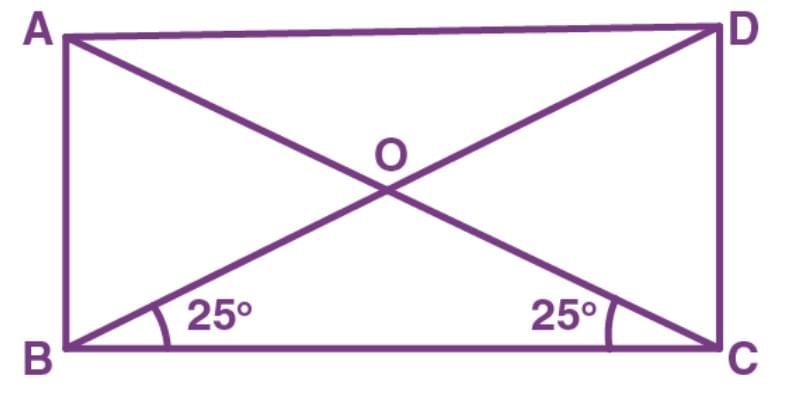
In a triangle BOC,
∠OBC = ∠OCB (Opposite angles of isosceles triangle)
Therefore, ∠OBC + ∠OCB+∠BOC = 180º
25º+25º + ∠BOC = 180º
∠BOC = 180º- 50º
∠BOC = 130º.
By using the linear pair,
∠AOB + ∠BOC = 180º
∠AOB = 180º – 130º
∠AOB= 50º
Hence, the acute angle between the diagonals is 50º.
Q10: ABCD is a rhombus such that ∠ACB = 40º. Then find ∠ADB. (3 Marks)
Sol: We know that the diagonals of the rhombus bisect each other perpendicularly.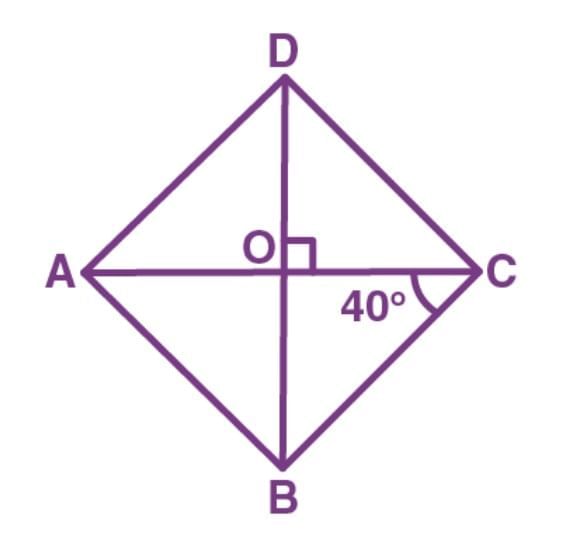
By using the alternate interior angles, and angle sum property of triangle, we can say:
From the triangle, BOC,
∠BOC + ∠OCB + ∠OBC = 180º
(where ∠BOC= 90º, ∠OCB = 40º)
90º+40º+ ∠OBC = 180º
∠OBC = 180º – 130º
∠OBC = 50º
∠OBC =∠DBC
Now, by using alternate angles, we can say
∠ADB = 50º
Q11: In the given parallelogram ABCD, find the value of x and y. (3 Marks)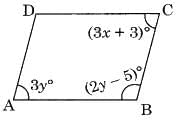 Sol:
Sol:
∠A + ∠B = 180° (adjacent angles of a parallelogram are supplementary)
3y + 2y – 5 = 180°
⇒ 5y – 5 = 180°
⇒ 5y = 180 + 5°
⇒ 5y = 185°
⇒ y = 37°
Now ∠A = ∠C [Opposite angles of a parallelogram]
3y = 3x + 3
⇒ 3 × 37 = 3x + 3
⇒ 111 = 3x + 3
⇒ 111 – 3 = 3x
⇒ 108 = 3x
⇒ x = 36°
Hence, x = 36° and y – 37°.
Q12: Find the values of x and y in the following parallelogram. (5 Marks)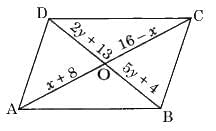 Sol: Since, the diagonals of a parallelogram bisect each other.
Sol: Since, the diagonals of a parallelogram bisect each other.
OA = OC
x + 8 = 16 – x
⇒ x + x = 16 – 8
⇒ 2x = 8
x = 4
Similarly, OB = OD
5y + 4 = 2y + 13
⇒ 3y = 9
⇒ y = 3
Hence, x = 4 and y = 3
Q13: ABCD is a rhombus with ∠ABC = 126°, find the measure of ∠ACD. (5 Marks)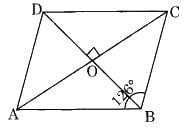 Sol: ∠ABC = ∠ADC (Opposite angles of a rhombus)
Sol: ∠ABC = ∠ADC (Opposite angles of a rhombus)
∠ADC = 126°
(Diagonal of rhombus bisects the respective angles)

⇒ ∠DOC = 90° (Diagonals of a rhombus bisect each other at 90°)
In ΔOCD,
∠OCD + ∠ODC + ∠DOC = 180° (Angle sum property)
⇒ ∠OCD + 63° + 90° = 180°
⇒ ∠OCD + 153° = 180°
⇒ ∠OCD = 180° – 153° = 27°
Hence ∠OCD or ∠ACD = 27°
|
26 videos|133 docs|11 tests
|
FAQs on Unit Test (Solutions): Quadrilaterals - Mathematics Class 8- New NCERT (Ganita Prakash)
| 1. What are the properties of different types of quadrilaterals? |  |
| 2. How can we calculate the area of a quadrilateral? |  |
| 3. What is the significance of the diagonals in quadrilaterals? |  |
| 4. How can we determine if a quadrilateral is a parallelogram? |  |
| 5. What are the different methods to prove that a quadrilateral is a cyclic quadrilateral? |  |





















